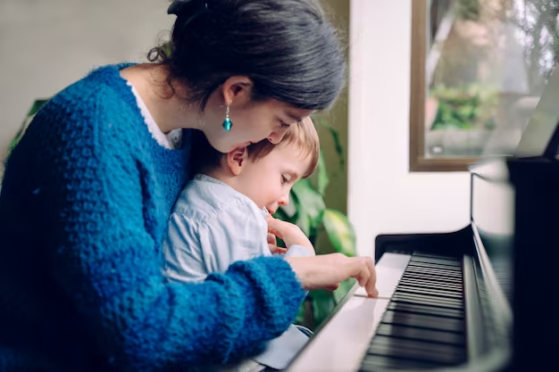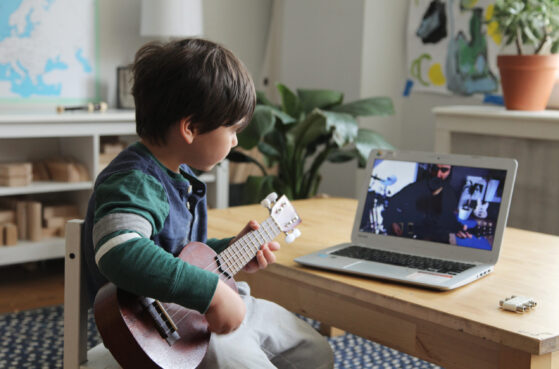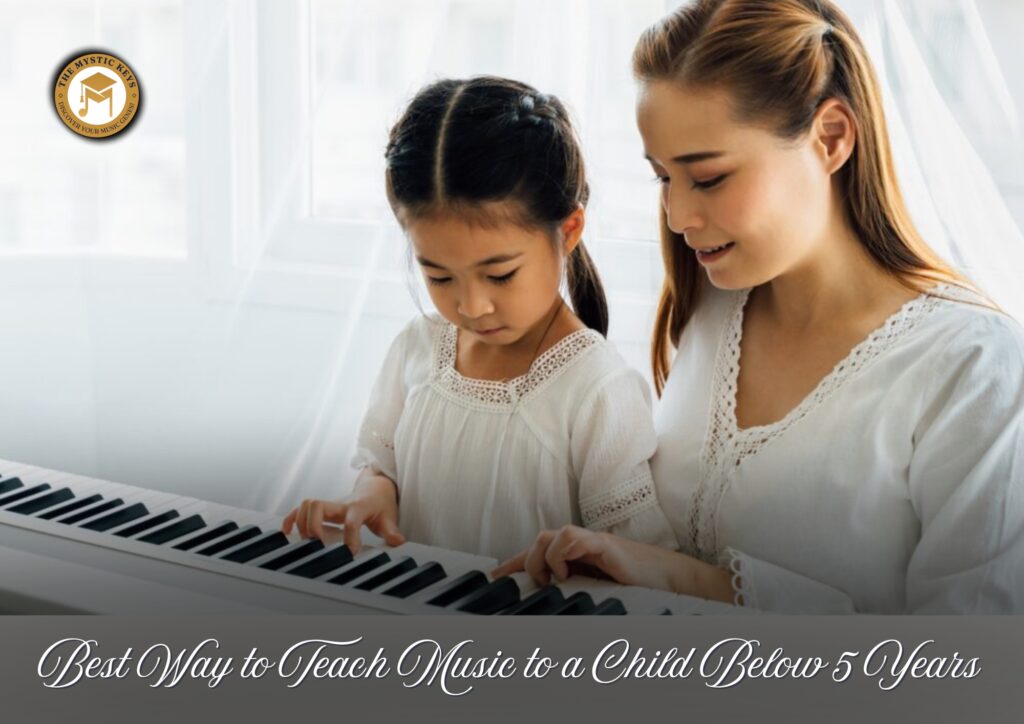The Best Way to Teach Music to a Child Below 5 Years
Teaching music to young children is not only an enriching experience for the child but also offers a wide array of developmental benefits. To teach music to a child below 5 years, it is essential to recognize the unique developmental needs of this age group. Music is a universal language that engages the mind, body, and emotions, helping children build essential skills, enhance creativity, and foster emotional intelligence. However, when it comes to teaching music to children below five years, it is crucial to tailor the approach to suit their developmental stage. The best way to teach music to such young children involves creating a nurturing environment, using play-based learning methods, and, crucially, involving the parents in the learning process.

Understanding Early Childhood Development and Music
At an early age, children are like sponges, soaking up everything around them, and their brains are highly receptive to stimuli. This is the perfect time to introduce them to music, as it can stimulate their cognitive, emotional, and social development. In the first five years, children begin to develop their sense of rhythm, pitch, and melody. They may not yet have the fine motor skills to play an instrument proficiently, but they can engage with music through movement, sound recognition, and vocalization.
During this period, music offers a multitude of benefits, including:
- Cognitive Development: Music improves memory, attention, and problem-solving skills.
- Language Skills: Singing songs and rhymes helps with language development.
- Motor Skills: Dancing and clapping along with rhythms promote physical coordination.
- Emotional Expression: Music provides a safe space for children to express and regulate their emotions.

The Importance of Parent Involvement in Early Music Education
One of the most effective ways to teach music to children under five is by incorporating a parent-centered approach. If a parent can learn and then teach their child at their own pace, it creates a bond between them while fostering a positive learning environment. It is well-known that children often learn best through observation and interaction with familiar adults. When parents engage in music learning, they serve as role models for their child, reinforcing the joy and importance of music in everyday life.
Parents can engage in simple musical activities with their children at home, creating a playful, low-pressure environment where the child feels encouraged to explore music at their own pace. By learning alongside their child, parents help to demystify the process of learning music, making it feel like a natural and enjoyable part of their lives. Moreover, this approach allows parents to tailor lessons to the child’s mood, energy levels, and interests, which can lead to better retention and more joyful learning experiences.

Creating a Playful Learning Environment
Music for young children should be fun, spontaneous, and engaging. The key to teaching music to a child under five is making sure the experience feels like play rather than formal lessons. Children this young have short attention spans, so sessions should be brief, around 15 to 20 minutes, filled with interactive activities that hold their interest. A variety of activities, such as singing, dancing, clapping, or using simple instruments, should be included to cater to the child’s individual preferences.
Here are a few tips to create a music-rich environment for your young child:
- Sing Daily: Singing songs and nursery rhymes with your child will help them develop an early love for music. Choose songs with repetition and easy-to-remember lyrics. Even toddlers can pick up songs through daily repetition.
- Movement to Music: Children love to move to music, and it’s a great way to develop rhythm and coordination. Play different types of music and encourage your child to dance, clap, or stomp along with the beats.
- Use Simple Instruments: Instruments such as tambourines, maracas, and small xylophones are great for young children to explore. Let them play freely and experiment with different sounds.
- Explore Different Genres: Expose your child to various types of music, from classical to folk, jazz to pop. This variety will help them develop an appreciation for the diversity of music.
- Rhythmic Games: Clap your hands in a rhythmic pattern and encourage your child to imitate the rhythm. You can also play games where you ask your child to copy simple rhythmic claps or foot taps.

Incorporating Music into Everyday Life
Music doesn’t need to be confined to formal lessons or set times. Parents can incorporate music into everyday life in a way that feels natural and unforced. For example, you can sing songs during playtime, use music to calm your child during transitions (like cleaning up toys), or play music during car rides. By infusing music into various aspects of your child’s day-to-day activities, you normalize its presence and make it a fun and integral part of their lives.

Encouraging Exploration and Self-Expression
One of the most important aspects to teach music to a child below 5 years is allowing them to explore and express themselves musically. Young children may not have the ability to play a formal piece of music, but they can create their own melodies, rhythms, and sound patterns. Encourage your child to experiment with sounds using their voice or instruments, allowing them to express their feelings through music. This type of creative exploration helps build confidence and nurtures their inner musician.

Setting Realistic Expectations and Patience
When teaching music to a child below 5 years, set realistic expectations and be patient. Children develop musical skills at different rates, and progress may seem slow. The goal isn’t to make them virtuosos but to build a lasting, positive relationship with music. Don’t worry if they don’t grasp concepts right away. Focus on creating a nurturing environment where they can experiment with sound and rhythm. Celebrate small victories, as these moments boost confidence and motivation. Encourage exploration, as it helps them develop creativity and an appreciation for music. Most importantly, let them enjoy the process, and the skills will follow naturally.

The Role of Music Classes for Toddlers
While much learning can happen at home, enrolling a child in a toddler-friendly music class is also valuable. These classes, for instance, introduce basic musical concepts through play and offer social interaction with other children. Furthermore, they foster cooperation and teamwork through group music-making, allowing children to build essential social skills. Additionally, these classes give children a chance to explore new instruments and styles in a fun, structured setting. In the process, they also help develop a child’s listening skills and rhythm. Moreover, the classes provide a safe space for children to experiment with sound and express themselves. Most importantly, they ignite a passion for music in a collaborative and supportive environment.

The Key to Success | Teaching at the Child’s Pace
One of the most important principles in teaching music to young children is letting them learn at their own pace. Each child is unique, with some drawn to rhythm, others to melody or singing. It’s vital to respect their preferences and let them explore music in their own way. Pushing too hard can cause frustration, while allowing them to explore freely fosters a lasting love for music.
By learning and teaching at their own pace, parents create a relaxed, encouraging environment for their child’s growth. The key is making music a fun, everyday part of life—whether through singing, dancing, or playing instruments together. With patience, exploration, and creativity, children develop a deep connection to music that benefits them for years. This approach nurtures their confidence, independence, and emotional expression. It also helps them see music as an exciting, lifelong journey. Ultimately, it shapes their love for music and their ability to enjoy and create it for years to come.

Conclusion
Introducing music to a child below 5 years is joyful and requires patience and creativity. To teach music to a child below 5 years, create a playful environment, include music in daily life, and involve parents. When parents learn alongside their children and go at their own pace, they foster a lifelong love for music and strengthen their bond. The best approach is to make music fun, engaging, and natural. Join The Mystic Keys to embark on a musical journey that enhances creativity and development. Start your child’s musical adventure today!








